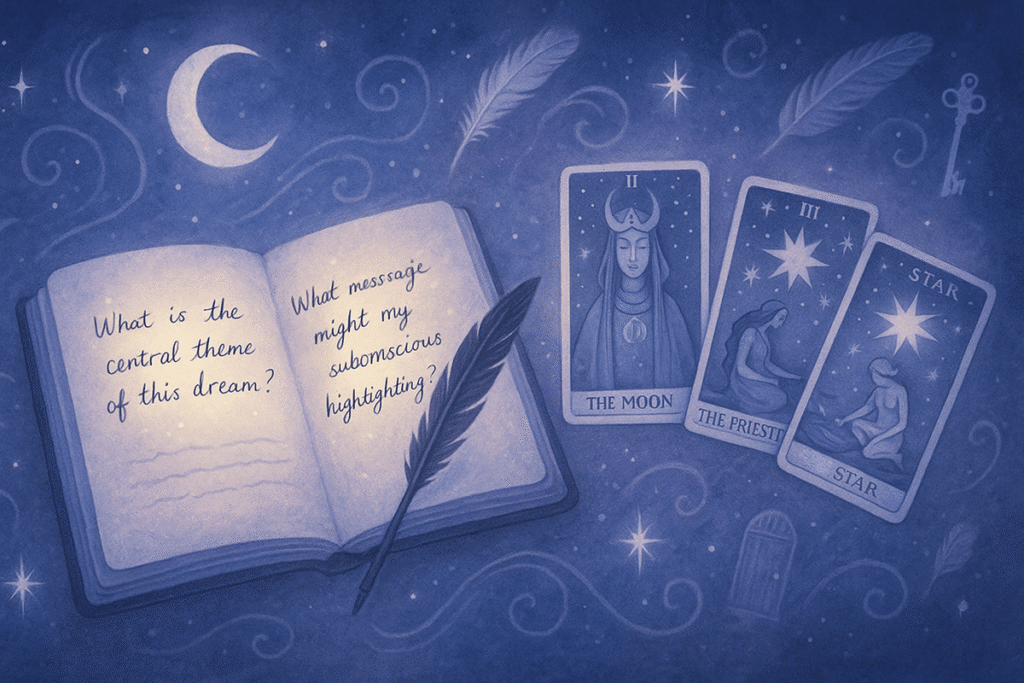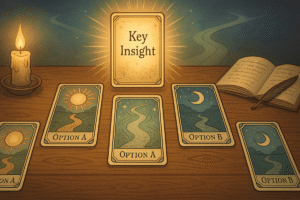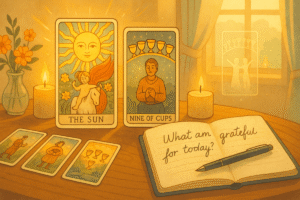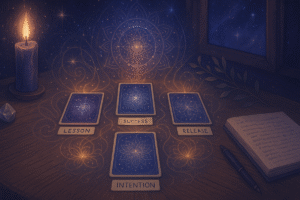Table of Contents
Dreams have always fascinated me, especially those that keep returning night after night. You know the ones I mean. The dreams that leave you wondering what your mind is trying to tell you. Perhaps you’ve experienced that feeling too, waking up with fragments of vivid imagery that seem important but remain frustratingly unclear.
I’ve found that combining dream exploration with tarot journaling creates a powerful practice for personal reflection. This isn’t about predicting your future or providing definitive psychological analysis. Rather, it’s a gentle way to engage with the symbolic language of both dreams and tarot cards, allowing your own wisdom to emerge through thoughtful contemplation.
Understanding Dreams as Personal Symbols
Our dreams speak in a language of symbols, emotions, and metaphors. Sometimes I think they’re like puzzle pieces scattered across our subconscious, waiting for us to arrange them in ways that make sense to our waking minds. The imagery that appears in recurring dreams often carries personal significance that only we can truly decode.
When we approach dreams with curiosity rather than seeking absolute answers, we open ourselves to deeper self understanding. Each dream symbol holds layers of meaning that might shift depending on what’s happening in our lives. A house in your dream might represent security during one period, but transformation during another.
This is where tarot becomes a valuable companion in dream exploration. The cards don’t hold magical answers about what your dreams “really mean.” Instead, they offer archetypal images and themes that can help you reflect on your own dream symbolism from different angles.
Creating Your Dream and Tarot Journal
Setting up a dedicated space for this practice feels important to me. I keep a simple notebook beside my bed, though you might prefer a digital journal or voice recordings. The key is having something readily accessible for those moments when dream memories are still fresh.
Your dream journal becomes the foundation of this reflective practice. When you record a dream, try to capture not just the events but also the emotions you felt, the colors you remember, and any sensations that stood out. Don’t worry about making it perfect or complete. Sometimes the most meaningful insights come from fragments.
After recording your dream, you’ll draw tarot cards to explore different aspects of what you’ve experienced. This isn’t fortune telling, but rather a structured way to examine your dreams through various lenses. Think of the cards as conversation starters with your own subconscious mind.
The process works best when you approach it with an open, non judgmental attitude. Some days the connections between cards and dreams might feel immediately clear. Other times, you might sit with the images for weeks before understanding begins to emerge. Both experiences are perfectly valid.
The Three Card Dream Reflection Spread
I often use a simple three card layout when exploring recurring dreams. This spread helps break down the dream experience into manageable components for reflection. You can adapt this approach to fit your own style and needs.
Draw three cards and place them in a row. The first card represents the central theme or energy of your dream. As you look at this card, ask yourself what emotions or situations in your waking life might resonate with the imagery. Perhaps the card shows conflict, and you recognize similar tensions in your daily relationships.
The second card explores the message your subconscious might be highlighting. This isn’t about receiving a direct communication, but rather about considering what aspects of your life need attention or reflection. The card might prompt questions about areas you’ve been avoiding or patterns you haven’t noticed.
The third card represents potential pathways for growth or understanding. What perspectives might you explore? How could you integrate the dream’s themes into your conscious awareness? This card often reveals resources or approaches you already possess but haven’t fully recognized.
Remember, these interpretations come from your own reflections, not from predetermined card meanings. Trust your initial responses to the imagery, even if they don’t match traditional tarot interpretations.
Working with Recurring Dream Patterns
Recurring dreams deserve special attention in this practice. I think they’re like persistent knocks on the door of consciousness, repeating until we’re ready to invite them in for tea and conversation. When the same dream themes appear repeatedly, it often signals that something in our inner world is seeking acknowledgment.
Start by tracking the variations in your recurring dreams. Does the setting change? Do different people appear? Are there shifts in how you feel within the dream? These subtle changes can provide valuable clues about your evolving relationship with whatever the dream represents.
For recurring dreams, try drawing a single card each time the dream occurs, building a collection of reflective prompts over time. You might notice patterns in the cards that mirror patterns in the dream variations. This long term approach allows for deeper exploration than single session interpretations.
Consider creating a dedicated section in your journal for each recurring dream theme. This becomes a space where you can track not just the dreams and cards, but also your evolving thoughts and insights about what these nighttime visits might represent in your life.
Journaling Prompts for Dream Card Work
Effective journaling prompts can guide your exploration without forcing predetermined interpretations. I’ve found these questions helpful for connecting tarot imagery with dream symbolism, though you should feel free to develop your own approaches.
When looking at your drawn cards, consider asking yourself what feelings the card imagery evokes. Does it remind you of specific aspects of your dream? Sometimes the emotional resonance between card and dream creates more meaningful connections than literal symbol matching.
Explore how the card’s energy might relate to current situations in your waking life. What parallel themes do you notice? If your dream involved being chased and you drew a card showing forward movement, you might reflect on areas where you’re avoiding something that actually needs your attention.
Think about what the card suggests about your resources for handling whatever the dream brings up. Perhaps you dreamed of being lost, but the card shows themes of inner wisdom or guidance. This combination might prompt reflection on times you’ve successfully navigated uncertainty.
Ask yourself what questions the card raises about your dream experience. Rather than seeking definitive answers, let the cards generate new avenues for self exploration. Sometimes the most valuable insights emerge from questions we hadn’t thought to ask.
Seasonal and Cyclical Dream Patterns
I’ve noticed that dream themes often shift with life seasons, both literal and metaphorical. Pay attention to whether certain dreams appear during specific times of year, life transitions, or emotional cycles. This awareness can deepen your understanding of how your subconscious responds to different energies and challenges.
When you notice seasonal patterns, try drawing cards specifically to explore these cycles. What themes emerge during periods of change in your life? How do your dream symbols evolve as you move through different phases of growth or challenge?
This cyclical awareness adds another layer to your practice. You might discover that dreams appearing during stressful periods carry different symbolic weight than those emerging during peaceful times. The same dream symbol might invite different reflections depending on your current life context.
Creating seasonal sections in your journal allows you to track these longer patterns. Over time, you might recognize how your psyche uses dream language to process different types of experiences or prepare for upcoming transitions.
Building Your Personal Symbol Dictionary
As you continue this practice, you’ll likely notice personal symbols that appear regularly in both your dreams and your card draws. These become part of your unique inner vocabulary, carrying meanings that evolve through your reflective practice.
Keep track of symbols that feel particularly significant to you. A crow might consistently appear in dreams during times when you need to pay attention to your intuition. If crows also appear frequently in your tarot draws during dream work, this creates a personal association worth exploring.
Your symbol dictionary becomes a living document that grows with your self understanding. Unlike fixed interpretations found in books, your personal associations develop through lived experience and honest reflection. Trust these developing patterns while remaining open to their evolution.
Remember that symbol meanings can shift over time. What represents fear in one period of your life might later transform into a symbol of strength or wisdom. This fluidity reflects your own growth and changing relationship with different aspects of experience.
Integrating Insights into Daily Life
The real value of this practice emerges when insights begin influencing your waking awareness. You might notice dream themes reflected in daily situations, creating opportunities for more conscious responses to life’s challenges.
Sometimes dream work reveals patterns you weren’t consciously aware of. Perhaps your dreams consistently show themes of communication difficulties, and your card draws emphasize the need for clearer expression. This recognition might inspire you to pay closer attention to how you communicate in important relationships.
Integration doesn’t require dramatic life changes. Small shifts in awareness often create ripple effects throughout your experience. Noticing a tendency to avoid conflict in dreams might help you recognize similar avoidance patterns in daily interactions.
The practice of regular reflection creates a bridge between unconscious and conscious awareness. This bridge strengthens over time, making it easier to access your inner wisdom in various situations.
Maintaining Consistency Without Pressure
I think consistency matters more than perfection in this practice. Even brief moments of dream reflection can provide valuable insights. Don’t worry if you miss days or if some journal entries feel more meaningful than others.
Some people prefer daily dream work, while others find weekly or monthly sessions more sustainable. Find a rhythm that fits your life without creating additional stress. The goal is supportive self exploration, not another item on your to do list.
During busy periods, you might simply record dreams without immediately exploring them with cards. Building a collection of dreams gives you material for deeper reflection when time allows. There’s no expiration date on dream exploration.
Trust that your subconscious will continue offering relevant dreams regardless of how consistently you engage with this formal practice. The dreams that most need your attention often persist until you’re ready to explore them.
This gentle approach to tarot and dream work creates a sustainable practice for ongoing self discovery. By treating both dreams and cards as invitations for reflection rather than sources of definitive answers, you honor your own capacity for insight and growth. The combination becomes a powerful tool for understanding the rich symbolic language of your inner world.
Disclaimer: This article is intended for personal reflection and self exploration purposes only. It is not meant to replace professional psychological counseling, therapy, or medical advice. If you are experiencing persistent disturbing dreams or mental health concerns, please consult with qualified healthcare professionals.
Frequently Asked Questions
What if I can’t remember my dreams well enough to journal about them?
Start by keeping your journal right beside your bed and writing down even small fragments immediately upon waking. Set a gentle intention before sleep that you’d like to remember your dreams, without creating pressure or anxiety. You can also try drawing a single tarot card before bed as a way to prime your subconscious for dream awareness. Many people find their dream recall naturally improves once they begin the practice of recording whatever they do remember, even if it’s just a feeling or a single image.
Do I need to know traditional tarot meanings to use this practice?
Not at all. This journaling approach works best when you trust your own responses to the card imagery rather than relying on predetermined meanings. When you draw a card, focus on what emotions or thoughts it brings up for you in relation to your dream. Your personal associations with the symbols, colors, and figures on the cards are far more valuable for self reflection than memorized interpretations from a book.
How soon after having a dream should I do the tarot reflection?
The sooner you can record your dream and work with the cards, the better, as dream memories fade quickly. However, some dreams benefit from sitting with them for a day or two before exploring them with tarot. If a dream feels particularly emotionally charged, giving yourself some distance can actually help you reflect more clearly. There’s no wrong timeline, and you can always return to dreams you recorded weeks ago for fresh insights.
What should I do if the cards I draw don’t seem to relate to my dream at all?
This happens more often than you might think, and it’s completely normal. Sometimes the disconnect itself is meaningful, suggesting that your conscious interpretation of the dream might be missing something important. Try looking at the cards from different angles or focusing on smaller details in the imagery. You might also set the reading aside and return to it later when your perspective has shifted. Not every card draw will produce immediate insights, and that’s part of the natural rhythm of reflective practice.







